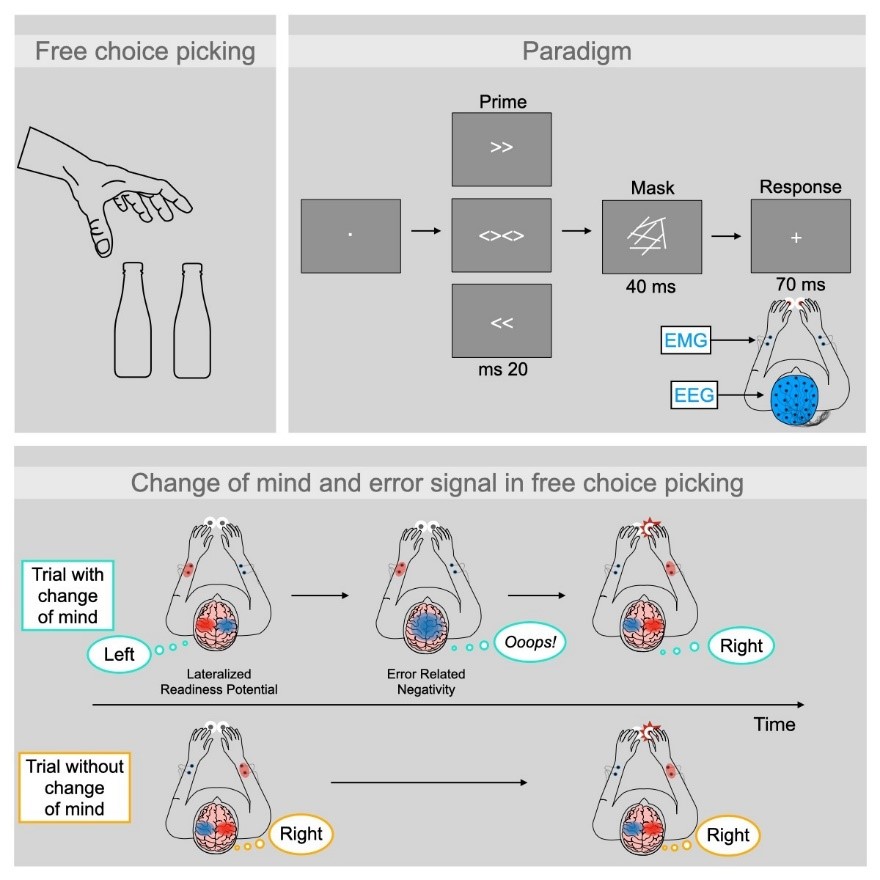Arbitrary decisions, in which there are no specific reasons to act in one way or another, have long been the focus of debates about the nature of “free will” (for example, in the exchange between Newton and Leibniz in the early 18th century). In a famous philosophical fable, Buridan’s ass starves to death, because, when it is placed equally distant between two identical stacks of hay, it cannot decide whether to approach the right haystack or the left haystack. In fact, we are frequently faced with such arbitrary choices that ultimately make no difference to us: Which of the identical soda cans shall I pick? Where shall I start setting the plates on the table for dinner? Which of the five identical new pairs of socks shall I put on? Do I enter through the left- or right-hand wing of the double door? Nevertheless, healthy people do not become paralyzed by such situations and can rapidly choose between such equal options, even when there are no rational reasons to rely on. In contrast, several clinical populations (as well as some healthy individuals) have significant difficulties in making such arbitrary decisions.
In this study, we used measures of human behavior, muscle activity (EMG), and brain activity (EEG) to ask whether the processes of arbitrary and non-consequential free-choice decisions (supposedly based on a whim) are actually subject to similar conflict and control mechanisms as meaningful, goal-defined decisions. Participants (n=16) had to decide freely and arbitrarily if to use their left or right hand when presented with a plus sign. Prior to this cue, an invisible prime was presented (either a left or right arrow or a neutral non-directional symbol, Figure). Change of mind was detected by the pattern of the EEG lateralized readiness potential (LRP), and by muscle activity (measured by EMG) in the non-responding hand. We show that “free” choice between equally desirable options (“picking”) can indeed involve a change of mind. Moreover, even in trials with neutral non-directional prime, change of mind was associated with an error-related electrophysiological response (the error-related negativity, ERN), although these responses involved arbitrary, non-consequential decisions where no errors are possible.
The implications of our findings are that even for arbitrary choices, which may be best dealt with by an emotionless coin flip, humans employ the same machinery as for deliberate decisions. This brings with it all the costs of conflict resolution, like hesitation, slowing, or possible paralysis. As the aptitude for resolving conflicts or cognitive dissonances differs between individuals, these findings pave the way for new directions of understanding deficits of decision making, such as in Obsessive Compulsive Disorder and anxiety.
Figure:

Top left: In free choice picking, one needs to decide between absolutely equal choices. Top right: In the experiment, participants had to arbitrarily decide if to use the left or right hand to press a button when presented with a plus sign. In some of the trials, they were presented with a left or right arrow and in other trials they were presented with a neutral non-directional symbol. These directional and non-directional symbols were masked by a screen of scattered lines, making the participants unaware of the prime. Although the primes were undetected by the participants they affected their free-choice picking behavior. One notable effect was that their response direction was biased towards the prime direction (~60%). However, a change of mind pattern appears when responding in the opposite direction of the prime direction and even in cases when the prime is neutral. Bottom: Pressing a button with a certain hand is associated with stronger negative electric-potential in the motor cortex contralateral to that hand (blue ellipses in the left and right participant figures). Thus, change of mind was detected by the pattern of the EEG underlying this potential difference (termed lateralized readiness potential (LRP)), and by muscle activity (measured by EMG) in the non-responding hand. The main result was that change of mind trials elicited error related negativity signals (ERN; blue central circle in the middle participant figure) in free choice picking decisions.
